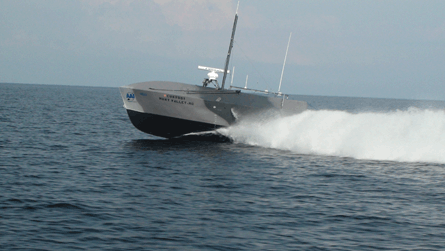Hunt Valley, Maryland-based AAI, most known as the builder of the venerable Shadow unmanned aircraft, is venturing into the water in a joint venture with Baltimore neighbor Maritime Applied Physics (MAPC).
The companies have introduced the Fleet-Class Common Unmanned Surface Vehicle (USV) to meet the needs of the US Navy, as outlined in the service's USV Master Plan, released in late 2007, and for the Littoral Combat Ship, which makes heavy use of unmanned systems for its missions. The Navy wants fleet-class ships for mine countermeasures, "protected passage" anti-submarine warfare and other surface missions.
AAI has been dipping its corporate toes into maritime systems for years, and in 2008 it showed that a ground-control station based on US Army One System software could operate USVs. It also developed a smaller Harbor-Class USV, also a component of the Master Plan, but aimed more at calm-water, near-shore missions.
 |
|---|
© AAI |
WORKING TOGETHER
The company began discussing joint work with MAPC and "together, we looked at developing and producing the first common [fleet class] USV," says Ryan Hazlett, AAI's director of advanced systems. "We actually put the boat in the water in mid-2009, and we've been developing it and have over 500 hours on the water."
Hazlett says the companies have demonstrated command-and-control capability, mission planning and exercise capability, the ability to launch and retrieve a payload, and the reliability of the vehicle during the "completely internally" funded project.
"We're now investing in a second common USV," he says, which should be available in the first quarter of 2011 or possibly even sooner.
That will include some spiral development, as AAI and MAPC will roll in some improvements derived from testing the first USV, including fine-tuned software. The first vehicle will continue as a demonstrator and engineering platform but the second will be available for sale. A series of demonstrations for the US Navy are planned.
The Fleet-Class Common USV is compatible with both configurations of the LCS (one built by a Lockheed Martin-led team, one by a team led by General Dynamics). MAPC builds the boat's launch and recovery system for General Dynamics' LCS design, so the USV is "designed with the constraints of that system in mind," Hazlett says, but will work on both. Like the LCS, it has a modular architecture that can accommodate different payloads.
"We looked at the future naval capability and built a system that could go out and meet multiple objectives," Hazlett says. "Unique attributes include its payload bay, which functions quite well. It can be used for [sensor] towing and mine warfare and countermeasures, anti-submarine warfare, and also has uses we see for extended ISR [intelligence, surveillance, reconnaissance] platforms, the potential to be a supply and resupply vessel, and could even carry personnel, although it's designed from the ground up to be an unmanned vessel."
SPECIFICATIONS
The vessel is 39 feet (11.9 meters) long, has a 10.25-foot beam, a top speed of 28 knots, a cruising range of 1,200 nautical miles and a towing capacity of 4,300 pounds (1,950kg), the company says. It's designed to operate in sea states up to sea state 4 (waves up to 2.5 meters) and survive up to sea state 6 (waves up to six meters), with a self-righting capability.
Hazlett describes the move as an "evolution" of AAI's experience with unmanned systems and MAPC's experience with maritime vessels.
"I think it's a natural extension of our core competencies here at AAI, involving integrating and controlling unmanned assets," Hazlett says. "This was really just a logical extension for us and the next domain to move into. We chose not to move directly into the ground domain due to the level of competition and the cluttered marketplace. We think that the Navy and the maritime domain is the future. They're just understanding the realm of the possible."
Source: Flight Daily News























